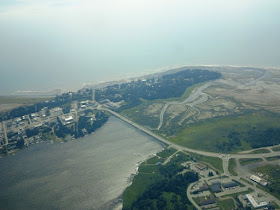When you go to Homer, Alaska, the first area you’ll
want to explore is the Homer Spit. This thin 4.5 mile stretch of land curves southeast
from the mainland like a tongue lapping at the sea.
 |
| Bridge from the mainland to the Homer Spit |
Archeological finds indicate that the Spit was
occupied by humans long before written history. Pacific Eskimo, Athabascan
Indians tribes, and Russian explorers all added their cultures, and the Spit improved
economically over time. As more settlers arrived, Homer grew to encompass the
foothills. After roads connected Homer to the rest of Alaska in 1950, towns on
the north side of Kachemak Bay like Homer grew in importance.
 |
| Aerial view of the strip of land called Homer Spit |
 |
| Tourists enjoy walking around to see shops, restaurants, and more on the Homer Spit. |
Our first morning in Homer, we made the 10-mile
drive to the end of the Spit, primarily to purchase licenses ($25 each) for our
halibut fishing excursion in the afternoon. Not being avid fisher people, we
chose to do this mainly for the experience—catching fish would be a bonus.
After a bumpy hour and three-quarters ride in a
relatively small boat to the spot populated by many halibut, we were instructed
to drop our baited lines (outfitted with a 2-pound weight) 200 feet to the
bottom of the ocean. Then the fun began! |
| I struggled to reel in a large halibut. |
“You have to reel it in yourself,” the guide told me. “And don’t stop until it’s in the boat.” Something about regulations that prevented them from catching the fish for us, especially since we were only allowed two halibut per person. I was determined not to be a total failure at this, even though I often wailed, “I can’t do this!”
 |
| We caught our limit--2 halibut each. |
So, I’ll tell you that fishing for halibut is hard work. Larry managed to get his
limit a while before I did. But I finally had my catches tagged and stowed,
awaiting what comes next.
Before beginning the filleting process on the return
boat ride, the guides offered to take pictures of us with our 60-80 pounds of
halibut. With all the fish filleted and bagged, the crew tossed scraps
overboard as an easy meal for the circling gulls.
 |
| Guides were very adept at filleting the fish. |
Since this was the beginning of our three-week trip, we decided not to have the fish shipped back to Texas. Instead, on the recommendation of a local Alaskan, we took the bag of filets to Captain Pattie’s Fish Market on the Spit. This restaurant cooked an amazing meal with our really fresh fish. And then the waitress set a huge platter of halibut filets fried with a light, fluffy crust on our table, enough for four more meals—which greatly satisfied our taste for halibut.
 |
| Each piece of fish is a serving size, so we enjoyed several meals from our catch. |
Photos by Larry and Beverly Burmeier






No comments:
Post a Comment